Picture Puzzles
by Hot
The first picture puzzles appeared in The Enigma only in August 1999, and therefore the rules are not yet hard and fast. Like some flat types, our picture puzzles were inspired by classical Italian puzzling. This article is a first attempt to define NPL guidelines for creating and solving picture puzzles.
There are two types of picture puzzles: picture rebuses, and illustrated flats. You can find more on Rebuses in the guide.
PICTURE REBUSES
Picture rebuses differ significantly from standard rebuses. The figure, with letters, bigrams, and/or trigrams (rarely other typographical characters) added, is the rubric, and there is no verse. The typographical characters are “read” from left to right. If none are added to the figure, the rebus is “silent”, and is of course more elegant. In a silent rebus, a star may be used to focus the solver's attention on a part of the figure, though the artist may prefer subtler ways to reveal what is important.
A good rebus must satisfy “Briga's triangle”: plausible picture, clever reading, and meaningful solution. (Briga is a leading Italian puzzler.) In general, the picture should represent one single scene, not a random collection of objects. The reading should preferably be a reasonably coherent description of what is in the picture, and heteronymic to the solution (in the sense that word breaks should not be the same — in fact, etymological overlap between reading and solution should be avoided.) The answer should be a word or a meaningful phrase. It does not necessarily have to be an entry, but it cannot be an arbitrary sequence of words that one has to labor to justify (unlike standard rebuses, where this is not a problem, because of the context presented by the verse.)
The picture may or may not include a clue to the solution. If not, two enumerations are given: one for the reading, and one for the solution. Here is an example:
1. PICTURE REBUS (*3, *3, 3 4 —> *5 2 *6)

=XEMU
(drawing by TMCAY)
Solution: Tim, Ono, fat hens —> Timon of Athens
If there are letters in the figure, they are shown without asterisks in the first enumeration.
2. PICTURE REBUS (1, 1 3 4; 1 3; 1 4 —> 9' 9)

=HOT
(drawing by DART)
Solution: E, U rip ides; T rag; E dies —> Euripides' tragedies
3. PICTURE REBUS (1 4 1; 4 —> 4 6)
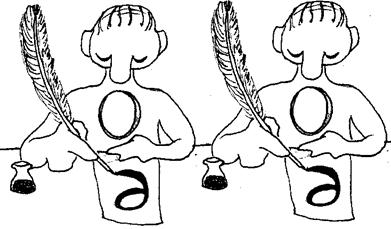
=DANDR
(drawing by RANDD)
Solution: O pens E; same —> open sesame
There are many rebus variations, including the reversed picture rebus, or picture suber. In the deletion rebus, the letters shown are removed rather than added in constructing the reading. In the addition rebus, the letters are inserted into words, as in the following example:
4. ADDITION REBUS (7 4)
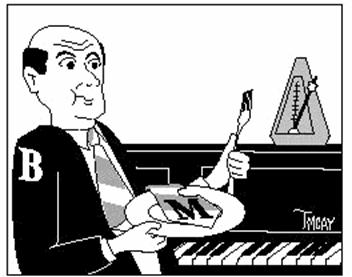
=FEDERICO
(drawing by T MCAY)
Solution: (B)eating ti(M)e
In a letter change rebus, the letters in the picture replace letters in the words:
5. LETTER CHANGE REBUS (3 4 4 —> 2 2 7)
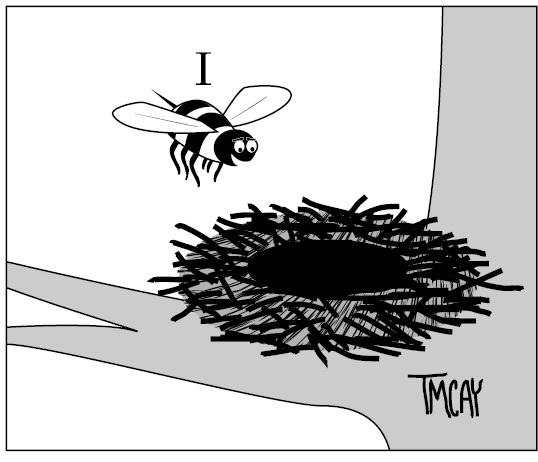
=FEDERICO
(drawing by T MCAY)
Solution: bee near nest —> be in earnest
ILLUSTRATED FLATS
Most flat types can be illustrated: the picture simply replaces the verse, and the rules about what bases are acceptable are the usual ones. Usually there are no cue words, though in some cases they might appear in dialog balloons, or on a poster or sign within the illustration.
The following example was originally a normal versified letter bank, but the concrete nature of the keywords makes it suitable for illustration:
6. LETTER BANK (5 5, 6 9, *7 *7 *7)
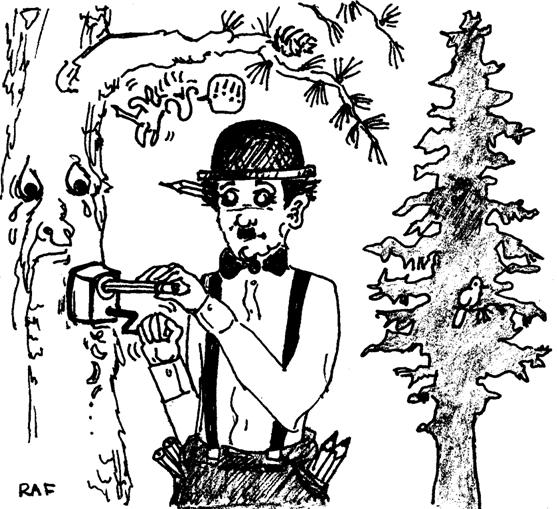
=TREESONG
(drawing by RANDD)
Solution: larch pines, pencil sharpener, Charles Spencer Chaplin
However a clever illustrator can find ways to illustrate more abstract keywords, and moreover those need not be limited to nouns.
7. PHONETIC BEHEADMENT (7, *5)
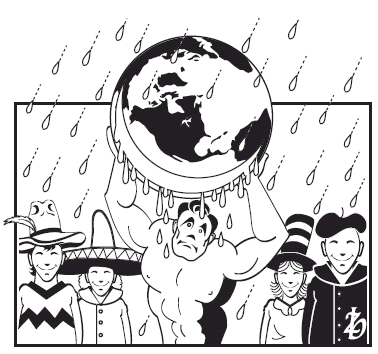
=HOT
(drawing by ZEBRA BOY)
Solution: hatless Atlas
Discovering illustratable bases is more difficult than finding versifiable bases, but most of the artistry is in conceiving and drawing the illustration. As in the picture rebus, it is best to use a coherent scene rather than an arbitrary collection of objects. This is similar to the preference for a meaningful story in a flat, rather than a meaningless juxtaposition of unrelated bits.
It is also possible to use the comic strip format:
8. LETTER BANK (enumeration withheld)
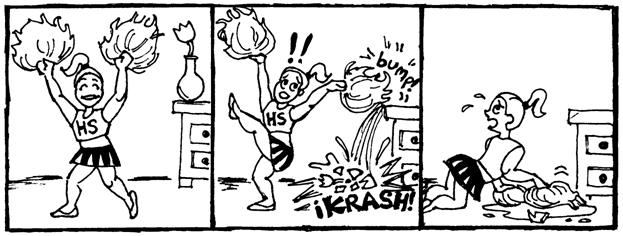
=ALICE
(drawing by RANDD)
Solution: mop, pom-pom
Finally, the illustrated acrostical enigma (invented by Dandr) has its own rules. The letters (A, B, C...) in the illustration point to clues to words whose beginnings are the end of words clued elsewhere in the figure (but with no labels). For example, there may be an A on an elephant, and a B on an osteopath. Somewhere else in the figure there may be a TOWel, and ERos. So the first part of the final solution would be TOW and the last would be ER. Here is an example:
9. ACROSTICAL ENIGMA (10)

=G. NATURAL
(drawing by DART)
Solution: SURfer(n), REAder(by), LImit(ten), SMile(x)
SUBMITTING PICTURE PUZZLES
If there is a picture puzzle sub-editor, he or she is responsible for matching picture puzzle bases with artists. Send bases, and any ideas you have about illustrating them, to him or her. Of course, if you can illustrate your own ideas, or want to work directly with an artist, you are welcome to do so. (Still, you may want to run your idea past the sub-editor, just to make sure the puzzle is likely to be accepted for publication.) Conversely, if you can draw, and are willing to illustrate other people's bases, be sure to let the picture puzzle sub-editor know!
If there is no picture puzzle sub-editor, you should work directly with an artist. The editor will have a list of interested artists.
Technicalities:
- As of now, our printing process does not deal well with greys. Black and white figures are preferable.
- Remember that most picture puzzles have to read clearly when shrunk to two inches across in order to fit in a normal Enigma column. Therefore, avoid tiny details, and remember that line weights also shrink when a figure is shrunk. Of course, make sure that the clue-bearing parts of the picture are large and clear.
- You can send hard copy, or electronic files (created on a computer, or scanned from a handmade drawing). Keep in mind that some members download The Enigma and print it on printers with resolution up to 600 dots per inch. On the other hand the hard-copy Enigma does not have such fine resolution.